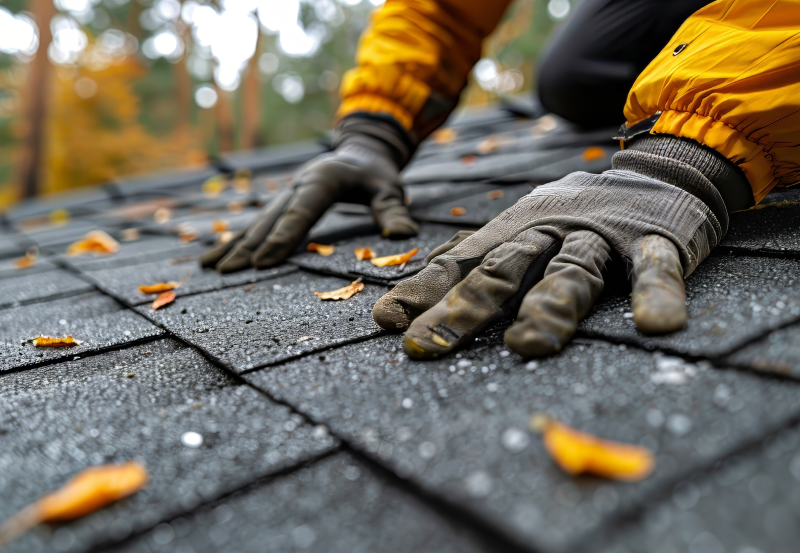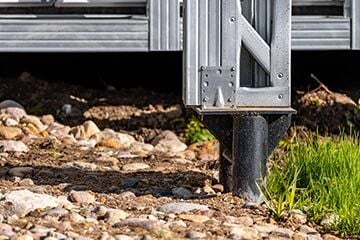There's nothing more reassuring than having a roof over your head, but ultimately they face the elements. Home insurance can protect you in the event your roof is damaged by something abrupt such as a storm or a falling tree.
But what happens if these occurances haven't led to you needing to repair or replace your roof? We'll examine the instances where you're able to claim on your home insurance policy.

Does my house insurance cover roof leaks?
So, admittedly there is a grey area when it comes to whether your home insurance policy can cover damage to your roof. But typically, damage to your roof can occur in two different ways - a sudden incident, or due to wear and tear, existing damage and poor maintenance.
Your home insurance policy generally covers unforseen incidents that lead to damage such as a storm, heavy rain or trees falling. For example, if a tree falls during a storm and crashes into your roof - you can usually claim on your policy.
However, if for example the materials over your roof begin to deteriorate over time, and it eventually leads to a leak - you aren't typically covered. Insurers will point to the damage occuring over time without action taken to repair the issue.
Will my insurer pay out for a roof damage claim?
This largely depends on what caused the damage.
As mentioned, if your roof was otherwise in good condition, sudden events leading to damage are likely to be covered. If you have any evidence or records of roof maintenance work, it can help prove to your insurer any damage was not due to owner negligence.
There are other circumstances that could lead to some form of damage to your roof such as fire, theft, attempted theft and vandalism. If any of these occur, a buildings insurance policy could cover your roof if you need to claim.
Will my insurer refuse to pay out for a roof damage claim?
Every home insurance policy sets out what you can and can't claim for - but some situations are fuzzy, so it's not always clear. This is especially true if you're claiming for roof damage, insurance providers often point to the existing condition and whether it has led to your claim.
For reference, the average cost of a storm damage claim for buildings insurance is £4,300*. The average cost of a storm damage claim for contents insurance is even more - £5,600*.
Your buildings insurer will largely expect you to maintain upkeep of your roof, not doing so could work against you if you need to claim. If there's heavy rainfall, and it leads to a leak, your provider could reject your claim on the basis you haven't properly maintained your roof.
Not all roofs are the same, non-standard houses such as a thatched roof cottage may require a specialist home insurance policy. Due to the specific materials used and the specialist nature of repairing or replacing a thatched roof, home insurance can be costlier. According to Confused.com data, the average cost of a combined (buildings and contents) annual home insurance policy for a property with a thatched roof (reed) is £1,544*.
If an insurer rejects your claim, and you aren't satisfied with the outcome, you can lodge a complaint. Your provider has to respond within 8 weeks, if you're still unhappy - you should contact the Financial Ombudsman Service. They can investigate the matter further - at no cost to you.
Does my home insurance cover contents damage caused by roof leaks?
A buildings home insurance policy does not cover your contents, but if you have a contents home insurance policy, it could offer some protection. This will largely depend on the roof leak and subsequent claim.
If a leak occurs due to poor maintenance and wear and tear, you're not likely to be covered. On the other hand, unforeseen sudden events that damage your contents due to a leaking roof could be covered. This would work in the same way your policy would protect you from other insured events such as fire, flooding and theft.
Does my home insurance cover my leaking roof if I live in a flat?
Whether you're covered for a leaking roof or not while living in a flat will depend on your living situation. The key difference is whether you own or rent the flat you're living in:
I rent the flat - In this instance, your landlord is responsible for maintaining the roof and the building of the flat. It isn't a legal obligation for a landlord to provide buildings insurance. Either way, a landlord must repair any building problems in a reasonable amount of time. If you're renting and have taken out a tenants insurance policy, this may cover your belongings if they are damaged to roof issues. You should check the policy documents to determine what you're covered for.
I own the flat - Your course of action will depend on whether you are a leaseholder, or a freeholder. A leaseholder should check the details of the lease to see who is responsible for the roof and the building insurance. A freeholder is responsible for the building and the roof - so having a buildings insurance policy in place could cover you depending on your claim.
How do I find a roof leak?
It's not always obvious to locate where a leak is coming from, but doing so early is important in making a successful claim. Not tending to the matter immediately could cause the roof to deteriorate, resulting in further damage to the structure - and a larger repair bill!
With that said, here's the best way to locate the affected area:
-
Find signs of moisture: Moisture or damp could be the first indication of a leaking roof. It's far more likely you'll find the affected area during wet conditions.
-
Inspect the loft: This is where you'll find the roof timbers, closely inspect the area for any moisture or mould. You should also look out for cracks of sunlight which indicate gaps in the roof tiles.
-
Wait for a rainy day: It sounds comical, but waiting for it to rain and spotting where water is coming through the roof is also useful.
-
Check the tiles: Looking for visibly damaged or missing tiles is part of good roof maintenance regardless of a leak occuring. Doing so can help you identify where the leak is coming from.
-
Flat roof: If you have a flat roof, you should inspect the outer coating of the roof for any cracks or breaks in the seam. Water is generally more likely to sit on a flat roof and eventually leak through and cause damage over time.
If you fail to identify the source of the leak, you could consider calling out a professional roofer. They might be able to help and advise what course of action to take.
How do I prevent my roof leaking?
Keeping your roof in good condition through regular maintenance can prevent leaks, but also help ensure any future claims are valid - if you make one. There are a few ways to do this:
-
Regularly check roof tiles/flat roof: Inspecting roof tiles/flat roof materials regularly for damage can prolong the lifespan of your roof. Ultimately the bill to replace a small section of your roof is a lot cheaper than replacing it entirely. You're liklier to pay more for home insurance if 10% or more of your roof is flat, this is due to the increased risk. The average cost of an annual combined home insurance policy when 10% of the roof is considered flat is £243*. This rises to £271* if 100% of the roof is considered flat.
-
Check guttering for blockages: Your gutters should be clear of all leaves and debris. Any blockages could cause a build up of water that may result in damage if left unchecked.
-
Keep roof clear of tress and plants: Be wary of any overhanging trees, plants, weed and moss. These can cause structural damage to the roof and building of the home should they fall, for example.
My roof is leaking. What should I do?
If you find a leak, swift action is necessary to prevent further damage from being caused. Doing so could limit the cost of repairs and increase the likelihood of a successful claim.
Managing the leak can be tricky but you should move contents away from the affected area before they're damaged. It's important to control the leak and catch water before it spreads with a bucket or other containers.
You'll need to take photos of every area that's affected whether it's the roof or any damage that's occured. It's also worth taking pictures of the weather outside if it contributed to the leak in the first place. Doing this can help your insurer process the claim quickly.
You should contact the insurance provider if you're looking to make a claim, they'll advise on the next course of action. For repairs, you'll need to think about contacting a professional roofer.
How do I claim for a damaged roof?
Your home insurance policy typically explains what you can and can't claim for. It isn't always clear, so you'll need to contact your insurer to explain the situation and your intention to claim. Here's what you'll need to do if you proceed with your claim:
-
Contact your insurer: It's vital you reach out to your insurer as quickly as possible. Having details such as your policy number and any other relevant documents to hand can speed up the process.
-
Gather information and evidence: It's important you gather as much information and evidence as possible. This includes photos of the roof, photos of the damage caused and any receipts of previous roof work done to prove it was in good condition.
-
Evidence of weather: If damage was caused by a storm then presenting photos/videos of the weather, or news reports of the storm can be used as proof.
-
Building work approval: If you require urgent repairs, these should be completed immediately. If the work required isn't urgent then you should wait for approval from your insurer first.
*Based on Confused.com data, May - July 2024.







